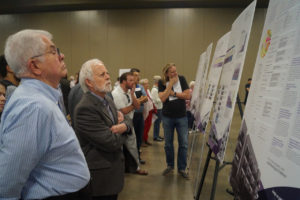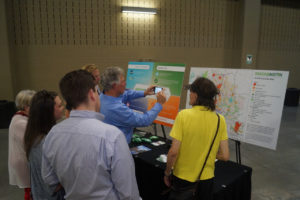 On February 1st, Austin City officials were pleased to see the bustling crowd at the Palmer Events Center. The Roll Out event was an opportunity for residents to obtain information about the new draft Land Development Code, which City staff had released just two days prior.
On February 1st, Austin City officials were pleased to see the bustling crowd at the Palmer Events Center. The Roll Out event was an opportunity for residents to obtain information about the new draft Land Development Code, which City staff had released just two days prior.
Among the attendees was Jay LeChien, who commutes to work in downtown Austin from Cedar Park. “Affordability was the primary reason why I moved to Cedar Park,” said LeChien. “We originally lived in south Austin and we loved it there, but as our family grew and we were looking at homes the reality was that the surrounding suburbs was where we were going to end up.”
 Attendees roamed around the exhibit hall viewing posters that focused on the priorities of CodeNEXT, priorities that came directly from residents through Imagine Austin and the Listening to Community Report. One priority is ensure a “vibrant and prosperous” Austin by establishing zoning codes that anticipate future growth while preserving the integrity of neighborhoods. Other priorities call for stewardship of the city’s environment and resources such as the water supply and creating a more walkable and connected Austin.
Attendees roamed around the exhibit hall viewing posters that focused on the priorities of CodeNEXT, priorities that came directly from residents through Imagine Austin and the Listening to Community Report. One priority is ensure a “vibrant and prosperous” Austin by establishing zoning codes that anticipate future growth while preserving the integrity of neighborhoods. Other priorities call for stewardship of the city’s environment and resources such as the water supply and creating a more walkable and connected Austin.
Perhaps the chief concern of attendees was ensuring Austin is an inclusive and affordable city. The draft code calls for more diverse housing choices to accommodate different kinds of families at different income levels. Also more incentives for developers to create affordab le units. Mayor Steve Adler addressed attendees saying, “We have affordability issues in this city where we’re losing people and we’re losing communities as people move away and our children can’t afford to live in the city that they grew up in to buy a home.”
le units. Mayor Steve Adler addressed attendees saying, “We have affordability issues in this city where we’re losing people and we’re losing communities as people move away and our children can’t afford to live in the city that they grew up in to buy a home.”
That resonated with Natasha Madison, an East Austin native who said she watched the city develop into a place she no longer recognizes.
Another priority of CodeNEXT addresses the complaints of developers about Austin’s complex zoning districts, and inefficient site planning and permitting processes. John Noell, a civil engineer with Urban Design Group said, “Our regulatory environment is much too complicated, much too time-consuming, not nearly predictable enough and these things combine to make the development of housing in Austin more expensive.”
 Dan Parolek of California-based Opticos Design Inc, the lead consultant for CodeNEXT said the new code is more predictable because it uses fewer combinations of zone districts and overlays.
Dan Parolek of California-based Opticos Design Inc, the lead consultant for CodeNEXT said the new code is more predictable because it uses fewer combinations of zone districts and overlays.
The all-important maps that will show how the new code will affect specific streets and neighborhoods aren’t expected until April, and it’s anticipated that the City Council won’t vote on the new code before December of this year. So, there will be many more opportunities for residents to get informed and get involved about CodeNEXT. Find out how on our blog. And, find out how the new code can create more opportunities for affordable housing.